
Investment grows to more than $8 billion along existing, future LRT lines
Extending Tracks Issue 19
Metropolitan Council sent this bulletin at 02/27/2018 08:50 AM CST
Developers are increasingly choosing to invest along light rail transit (LRT), as witnessed by the $8.4 billion in reported new investments along existing and future LRT lines in the Twin Cities metro region. That’s an increase of $1.6 billion in just a year.
The Metropolitan Council tracks developments proposed, under construction or completed along the METRO Green and Blue Lines, as well as the proposed Green and Blue Line Extension LRT projects (Southwest LRT and Bottineau LRT). As of the end of January 2018, total development is at least $8.4 billion, and likely even higher, given that many developments along the routes have not publicly disclosed their project value.*
“This new report documents some of the many positive impacts of light rail transit investments. Light rail reduces congestion, connects Minnesotans to jobs and educational opportunities, and supports private sector investment in our communities,” said Governor Mark Dayton. “Minnesota must continue making smart, strategic investments in transit infrastructure. Doing so will strengthen our economy and make our communities even better places to live.”
“In the past year alone, we have seen an increase of $1.6 billion for a total of $8.4 billion in development along LRT lines,” said Metropolitan Council Chair Alene Tchourumoff. “Businesses and developers choose proximity to light rail because they know that residents and workers of all ages are increasingly demanding access to transit – whether for housing, work, school, or entertainment.”
Timberland Partners is among the new developers, adding 599 housing units immediately adjacent to light rail in a trio of projects at both ends and in the middle of the Green Line/Green Line Extension.
And you can be sure the company will tout proximity to light rail in its marketing materials, said Ryan Sailer, Timberland Partners vice president of development, who disputes skepticism of the LRT effect on development.
“While you may not be able to attribute all development along the LRT to the LRT itself, the LRT has been a key driver in how cities look at redevelopment in terms of density, efficiency, housing affordability and creating cohesive development. Without the LRT, I don’t believe we would be seeing the activity, scale or diversity in projects we are currently seeing proposed and built by developers,” Sailer said.
Timberland Partners’ Green Line projects are its $61 million Elevate apartment/retail mixed-income project at SouthWest Station in Eden Prairie, its $40 million 333 on the Park luxury rental development in Lowertown St. Paul and its $56 million Green on Fourth mixed-income development adjacent to Prospect Park Station in Minneapolis.
Light rail has an undeniable economic impact, agreed David Wellington, director of acquisitions and development for Wellington Management, which has projects along the Green and Blue lines.

“There is clear and irrefutable evidence of this. We developed mixed-use properties along these lines, and it has turned into a place where people can live and have access to employment. I can say we would not have built our Lake Street Station building if the light rail line was not there,” Wellington said. Left: Map of development along proposed and existing light rail corridors The planned Southwest line has drawn attention to areas ripe for redevelopment, said Julie Wischnack, the city of Minnetonka’s planning director. “We had parts of our community that flew under the radar, like Opus. Now with light rail coming, it’s allowing people and developers to see other areas that may have gone unnoticed,” Wischnack said. “At its basic level, Opus was ready for redevelopment. When you add mass transit to the formula, it takes that redevelopment to the next level.” Experienced developers who have developed projects close to existing LRT lines have already been inquiring about sites along the proposed Blue Line Extension in Brooklyn Park, said Kim Berggren, Brooklyn Park’s community development director. “Our businesses and educational institutions, including North Hennepin Community College, recognize the importance that the next generation of workers places on access to frequent transit service. The Blue Line Extension will give Brooklyn Park a competitive advantage in attracting young talent. Design Ready Controls and Takeda Pharmaceuticals are two of our businesses who cite the Blue Line Extension as a reason for locating in Brooklyn Park,” Berggren said. Connecting workers to jobs There are already 64,300 jobs within one-half mile of the 15 planned Southwest LRT stations and another 16,600 jobs are expected to be added by 2035. Once completed, Southwest LRT will connect workers to job centers such as: • Park Nicollet Methodist Hospital • Downtown Hopkins • Opus Business Park • Optum corporate headquarters • Golden Triangle Business Park • Eden Prairie Center shopping mall. Three of Minnesota’s 17 Fortune 500 companies are located on the Southwest line: • CH Robinson • SuperValu • UnitedHealth Group • Another six Fortune 500 companies are on the exist- ing LRT lines in downtown Minneapolis. The Blue Line Extension has 16,200 jobs within one-half mile of its 11 planned new stations and is expected to grow to 20,800 jobs along the route. Target, another Fortune 500 company, has its Northern Campus in Brooklyn Park as a major job center on the line.
|
Development highlights along individual LRT corridors
Green Line: $5.8 billion in development, with more than half outside downtown Minneapolis
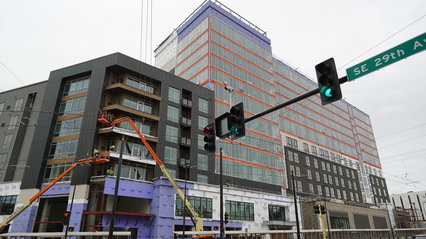
The Met Council has tallied $5.8 billion in development announced, under construction or already built along the Green Line, up from the previously reported $5.1 billion in January. More than half of that growth ($2.908 billion) has occurred outside downtown Minneapolis. Above: The Link at Prospect Park on the Green Line, near the Prospect Park Station In St. Paul The other half ($2.871 billion) has occurred along the mile of track with five stations shared by the Blue Line in downtown Minneapolis. Development highlights include mixed-income housing around the Minneapolis-St. Paul border between the Prospect Park and Raymond Avenue stations and general economic revitalization along the eastern end of University Avenue. |
Southwest: More than $1 billion worth of development
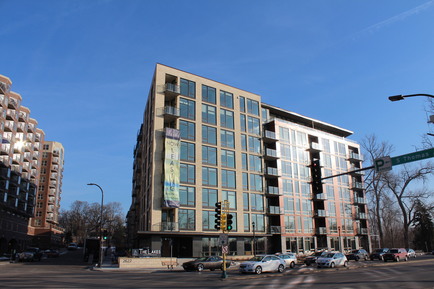
The Southwest LRT Project, which will begin construction in 2018 and open in 2023, has experienced more than $1 billion in development announced, under construction or built, up from $515 million reported in January 2017. Left: The Moline in Hopkins, near the Downtown Hopkins Station on the SWLRT line Highlights include a mix of projects around the planned West Lake Street Station in Minneapolis, the recently opened Moline apartments adjacent to the Downtown Hopkins Station, the $60 million Mariner apartment project planned near Opus Station in Minnetonka and the $61 million apartment/retail mixed income Elevate project at SouthWest Station in Eden Prairie. |
Blue Line: More than $1 billion in development
Development along the region’s first line, the METRO Blue Line, is valued at a little more than $1 billion as compiled for only 24 of the 41 projects tracked on the non-shared portion of that corridor in south Minneapolis and Bloomington. The actual value of development along this line is higher because the Met Council began tracking investments only in the last year and what information was originally reported is outdated or incomplete. Projects completed along this line in 2017 include the Richard A. Brustad Homes at the VA Medical Center Station in Minneapolis and Millworks Lofts at 38th Street Station in Minneapolis.
Blue Line Extension: More than half a billion dollars worth of development
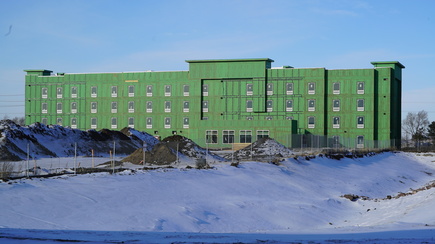
Planned and recent development along the Blue Line Extension tallies up to $522 million in investment, up from $489 million reported in January 2017. Commercial, industrial and hotel development is occurring north of Interstates 94/694 to Highway 610 Above: Hampton Inn and Home2Suites in Brooklyn Park near the 93rd Ave. Station on the Blue Line Extension at the line’s northernmost point. Projects under construction on the Blue Line Extension include the approximately $16 million 610 Commerce Center phase 2 and the $16 million Capstone II office/industrial buildings, both near the 93rd Avenue Station in Brooklyn Park, and the $8 million Brooklyn Boulevard Industrial Center near Brooklyn Boulevard Station. The Blue Line Extension Project will connect downtown Minneapolis to the northwest suburbs. |
Public can comment on proposed corridor protection wall, other changes
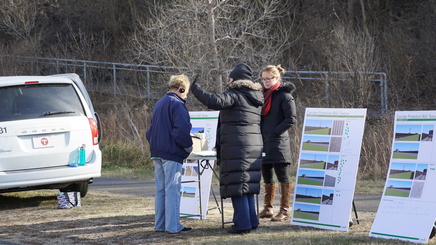
People who want to comment on the proposed corridor protection wall and other design changes to the Southwest LRT Project can speak or submit written remarks at a March 22 meeting at Dunwoody College, 818 Dunwoody Blvd Minneapolis, MN 55403. Above: SWLRT Outreach Coordinator Sophia Ginis speaks with members of the public during a corridor protection wall pop-up event on the Kenilworth Trail The public comment period started on Feb. 23, and comments will be taken until April 9, 2018 online at www.swlrt.org, by emailing swlrt@metrotransit.org or by mailing: Ms. Kelcie Campbell, Environmental Project Manager The March 22 town hall-style meeting at Dunwoody will begin at 5 p.m. with an open house where the public can view written information about the project’s joint Supplemental Environmental Assessment (SEA)/Amended Draft Section 4(f) Evaluation. An overview presentation will follow at 6 p.m. Afterward, people will have three minutes apiece to speak publicly to a panel of Metropolitan Council members and Hennepin County commissioners. In advance of the meeting, the public may view the project’s joint federal/state environmental review online at www.swlrt.org and they also will be able to view comments on it at the end of the public comment period on April 9, 2018. Responses to the comments will be posted in late spring 2018 with the Notice of Decision. Next steps The FTA will publish its findings and final decision in the Federal Register for this Supplemental EA/Amended Draft Section 4 (f) Evaluation. The Metropolitan Council will also be asked to review the findings and act on its final decision, which will be published in the Minnesota Environmental Quality Board Monitor. If future design changes are made to the project, the environmental team will work with the FTA to determine if additional study is warranted. What the review covers The scope of the document includes changes such as: • Parcel 322A parking impact near Opus Station (Minnetonka) • Minnehaha Creek headwall modifications (St. Louis Park) • Cedar Lake LRT Regional Trail detour (St. Louis Park) • 31st Street realignment (Minneapolis) • Grand Rounds Historic District: Kenilworth Lagoon Works Progress Administration (WPA) rustic style retaining walls rehabilitation and landscaping (Minneapolis) • Right-of-way adjustment near West 21st Street Station (Minneapolis) • BNSF agreement modifications (corridor protection elements including a proposed barrier between freight rail and light rail tracks in Minneapolis, pursuant to an agreement between the Metropolitan Council and BNSF Railway). • Bryn Mawr Meadows trail mitigation (Minneapolis) • Water service to Sharing and Caring Hands (Minneapolis) • New potential construction laydown areas (St. Louis Park and Minneapolis) |
Public influenced proposed corridor protection wall design through variety of ways
A working group, tours, community/neighborhood meetings, an open house and pop-up trail info sessions were among ways the public influenced the design of the proposed corridor protection wall between freight rail and light rail tracks in Minneapolis.
The Bassett Creek Valley Working Group was modeled after the success of the Kenilworth Landscape Design Group. The Bassett Creek group was created to serve as a voice for the community and liaison to the appointing organization, provide guidance on the aesthetic treatment of the proposed wall and advise on communications and outreach strategies related to the process. The group met four times in late 2017 and toured the corridor, ending in a resolution of proposed wall design preferences.
The working group’s resolution stated the design should use a dark color and vines to soften the proposed wall’s impact and make it recede into the landscape. The proposed wall can benefit trail users and LRT riders by shielding them from the sight of the industrial corridor occupied by freight rail, the resolution says.
Read the recommendations here:
https://bit.ly/2FdTfEV
In addition to the working group, project staff also met with the Bryn Mawr Board, Harrison neighborhood and Bassett Creek Redevelopment Oversight Committee. Staff also conducted five tours for policy makers and three public tours as well as pop-up sessions along the Kenilworth trail to share information with commuters and recreational trail users.
Peruvian-born Community Design Group owner provides bridge between engineers, public
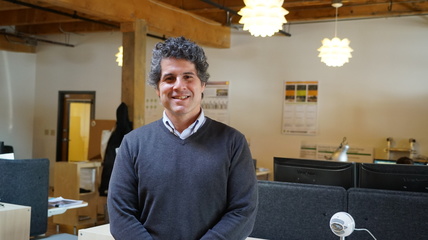
The Southwest LRT Project has its fair share of bridges. For Community Design Group, bridges between community members and policy makers are just as important. Left: Community Design Group Founder and President Antonio Rosell at CDG headquarters in the NorthLoop of Minneapolis The Minneapolis-based company has been making a name for itself nationally for nearly 20 years with its combination of community outreach and modern urban design. The company is the brainchild of civil engineer and planner Antonio Rosell, who recognized early in his career a disconnect between project planners and the communities they were trying to serve. Rosell had his eureka moment while studying architecture at the University of Minnesota. “Studying architecture was very eye opening because it gave me the language to understand that we as engineers shape the built environment and our cities and places in ways that determine how people live – and that we get little or no training as civil engineers on how to think about that we shape cities as engineers, but we don’t get any tools on how to understand or shape our impact,” Rosell said. At the time, Rosell was a graduate student studying regional urban planning at the University of Minnesota. It wasn’t until Kris Nelson, a professor at the university’s Center for Urban and Regional Affairs (CURA), suggested that he spend time with a community group in Minneapolis that Rosell says the idea of Community Design Group really began to take shape. “It was at the time that design for our region’s first light rail line was getting finalized. I was working with community members in the Ventura Village neighborhood in Phillips, and taking their ideas and aspirations for how they wanted their community to evolve – including how it connected to LRT and its benefits – and assembling documents that we could take forward to Hennepin County and the Met Council so that their vision could be understood by policy makers. I was also taking all the plans and engineering documents from the LRT design process and translating them into materials that neighborhood residents could understand and interact with,” Rosell said. And like that, Community Design Group was born. First working out of his apartment, then the basement of the home he shares with his wife and three children, Community Design Group now occupies a trendy suite in Minneapolis’ North Loop neighborhood. With eight employees and contracts spread across much of the United States, business continues to be brisk. Closer to home, the company has worked on several projects across Minnesota, including the city of Edina Pedestrian and Bicycle Plan, comprehensive plans for Grand Marais and International Falls, and the Southwest LRT project. For the Southwest LRT Project, Community Design Group is a sub-contractor for Perkins+Will, who asked the company to use its expertise in community outreach to engage residents in the Kenilworth Corridor. Rosell and his staff take an interesting approach to outreach. Rather than having large meetings, they would rather talk to people where they live, work and play. That may mean setting up a booth at a school or grocery store, or in the case of the Kenilworth Corridor, holding a pop-up event to engage directly with the people who use the walking and biking trails in the area. Sarah Ghandour, Southwest LRT’s assistant manager of design, said the innovative approach Community Design Group brings to the table has helped project designers immensely. “With a project as big as the Southwest LRT project is, talking to community members and getting their input is a big undertaking. The more we engage with the community as designers the more we can come up with a design that serves both the project’s purpose as well as the surrounding communities. Community Design Group does a really good job of reaching out to people that we may not have connected with through traditional outreach, so the service they provide really gives us the variety of opinions that ultimately makes designing the project more complete,” Ghandour said. Rosell was born in Peru. During the economic and political upheaval of the late 1970s and early 1980s, Rosell’s parents decided to come to the United States, specifically Miami, under a tourist visa in 1981. When that visa expired, the family never left and remained undocumented until 1989. Thanks to the Immigration Amnesty Law of 1987, Rosell was able to apply for U.S. residency and attend college. In 1994, Rosell graduated with honors in civil engineering from Florida International University. Right after graduating, he took a job designing bridges with the Minnesota Department of Transportation. At first he thought he would stay in Minnesota for only a few years and eventually return to Florida. But obviously that plan changed. While being an immigrant and starting a successful business is the quintessential American success story, the company itself had a little bit of help. Besides bringing an innovative approach to the business, Community Design Group is also a certified Disadvantage Business Enterprise. The DBE program was created by the U.S Department of Transportation to help minority- and women-owned businesses work on transportation-related projects, including the Met Council’s transit projects. Requirements for participating in the DBE program include limits on personal net worth (less than $1.32 million). Also, participating firms need to meet Small Business Administration size standards as measured by annual gross receipts. Those standards vary by industry. Ownership must also be at least 51 percent female or persons of color. The DBE goal for the design contract of the Kenilworth Corridor phase of the Southwest LRT Project is 19 percent. Rosell said the DBE designation was something he originally struggled with, not only because of the paperwork involved, but also the feeling that the company should be recognized for the work it does and not the race of the person who runs the business. “At first, I was a little bit hesitant because people should just hire us because we are good. But the truth is as a small business in the landscape of consulting, we don’t get any breaks. The cities don’t want to hire us because they haven’t heard of us, the big firms have their usual go to’s or they grab the whole thing themselves. Getting the DBE certification really helped us get new work here in town and also has opened up avenues in other states. I would also say that of all the agencies we do business with, the Met Council is the most conscientious about having space for DBE firms,” Rosell said. Not only has the DBE designation helped Community Design Group find new work in Minnesota, Rosell said it also helping them in other states, such as Ohio, Michigan and Texas. Despite a booming business and plans to hire additional staff, Rosell said the core philosophy of the company isn’t going to change. “The focus of the work has always been community responsive, sustainability and forward thinking. That’s what we are about,” he said. |
New animation shows layout of stations in Eden Prairie
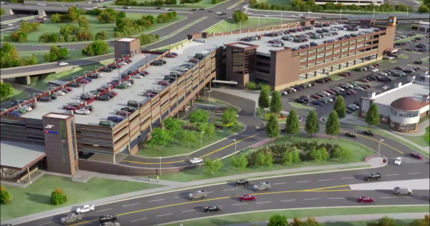
This visualization shows the design of METRO Green Line Extension’s SouthWest Station, Golden Triangle Station, and City West Station. Watch the video here: https://bit.ly/2EVbn94 |
About the Project:
The planned Southwest Light Rail Transit (LRT) Project (METRO Green Line Extension) will operate from downtown Minneapolis through the communities of St. Louis Park, Hopkins, Minnetonka, and Eden Prairie, passing in close proximity to the city of Edina. The line will connect major activity centers in the region including downtown Minneapolis, Methodist Hospital in St. Louis Park, downtown Hopkins and the Opus/Golden Triangle employment area in Minnetonka and Eden Prairie. Ridership in 2040 is forecasted at approximately 34,000 average weekday boardings. The project will interline with the METRO Green Line, which will provide a one-seat ride to destinations such as the University of Minnesota, state Capitol and downtown St. Paul. It will be part of an integrated system of transitways, including connections to the METRO Blue Line, the proposed METRO Blue Line Extension, the Northstar Commuter Rail line, a variety of major bus routes along the alignment, and proposed future transitway and rail lines. The Metropolitan Council will be the grantee of federal funds. The regional government agency is charged with building the line in partnership with the Minnesota Department of Transportation. The Southwest Corridor Management Committee, which includes commissioners from Hennepin County and the mayors of Minneapolis, St. Louis Park, Edina, Hopkins, Minnetonka, and Eden Prairie, provides advice and oversight. Funding is provided by the Federal Transit Administration, Hennepin County, Counties Transit Improvement Board (CTIB), Hennepin County Regional Railroad Authority (HCRRA), state of Minnesota, and other project partners. The Southwest LRT Project website is www.swlrt.org


